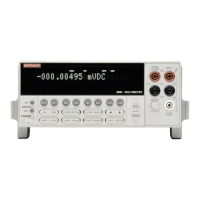Front Panel Operation
3-69
The data store capability of the Model 2001 could be used to
store the measurements as they occur. Just press the STORE
key to set the number of readings to store, then press EN-
TER. The Model 2001 waits (with the asterisk annunciator
lit) for an external trigger from the Model 7001 before taking
a reading, storing it, and sending a trigger pulse.
External triggering example #2
External triggering can also be used in a test system consist-
ing of a Model 2001 Multimeter and a Model 706 Scanner
with an appropriate scanner card.
The external trigger connections are the same as those shown
in Figure 3-27 for the Models 2001 and 7001. Channel
Ready Output of the Model 706 is connected to External
Trigger Input of the Model 2001. External Trigger Input of
the Model 706 is connected to Meter Complete Output of the
Model 2001.
The trigger configuration of the Model 2001 does not change
from the previous example. The Model 706 is configured for
external triggering.
3.7.7 Trigger Link
The Model 2001 has enhanced external triggering capabili-
ties using the Trigger Link. The Trigger Link has six lines al-
lowing up to six instruments to be controlled over this trigger
bus. The 8-pin micro-DIN sockets used for the Trigger Link
are shown in Figure 3-28.
NOTE
The two rear panel Trigger Link connec-
tors are actually connected in parallel. It
does not matter which connector you use
when connecting the Trigger Link to an-
other instrument.
In general, Trigger Link input triggers to the Model 2001 are
used to control the measure operation. For the Model 2001 to
respond to Trigger Link compatible triggers, the appropriate
layers of the trigger model must be programmed for it. For
example, if you want Trigger Link input triggers to control
the measuring process, you must program Measure Source
for TRIGLINK trigger events. Typically, a Trigger Link out-
put trigger from the Model 2001 would be used to trigger a
scanner to close the next channel.
There are two modes of operation for Trigger Link: asyn-
chronous and semi-synchronous. In the asynchronous mode,
separate lines are used for input and output triggers; in the
semi-synchronous mode, the same line is used for both input
and output triggers.
Asynchronous operation
In the asynchronous operating mode, Trigger Link functions
fundamentally in the same manner as External Triggering
(see paragraph 3.7.6). Like External Triggering, the
asynchronous mode uses separate lines for input and output
triggers. Also, the asynchronous mode uses the same TTL-
compatible pulses as External Triggering. The specifications
for the input and output trigger signals of asynchronous
mode are shown in Figure 3-24 and Figure 3-25,
respectively.
For typical asynchronous Trigger Link operation, the mea-
sure layer is configured with Measure Source set to
TRIGLINK and Triggerlink mode set to ASYNCHRO-
NOUS. You must also select input and output lines for the
measure layer. Input and output triggers can be set to any of
the six lines, but they cannot use the same line. For example,
if you select line #1 for input triggers, then output triggers
must use one of the other five lines (#2 through #6).
During operation in the measure layer, each Trigger Link in-
put trigger makes a measurement. After the user-pro-
grammed DELAY and the measurement settling time, the
Model 2001 outputs a Trigger Link completion pulse (typi-
cally to a scanner to close the next channel). The measure
layer is configured using the CONFIG-TRIG menu (see
paragraph 3.7.2).
The scan layer and/or arm layer can also be programmed for
Trigger Link, where Scan Source is set to TRIGLINK, and
Arm Source is set to TRIGLINK. When using Trigger Link
in these layers, you must also select input and output lines as
you did in the measure layer. Keep in mind that you can use
the same lines in the Scan and arm layers as selected in the
measure layer.
TRIGGER LINK
IN OUT
21
5
43
8
7
6
21
5
43
8
7
6
Pin Trigger Link Line
1 Line #1
2 Line #2
3 Line #3
4 Line #4
5 Line #5
6 Line #6
7 Digital Common
8 Digital Common
Figure 3-28
Trigger link connectors

